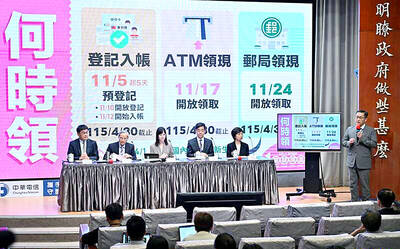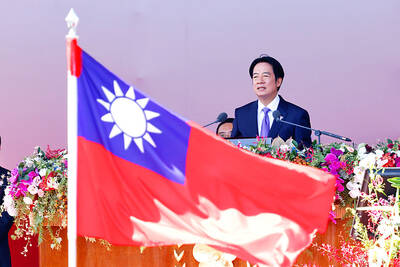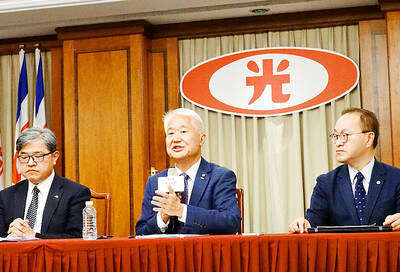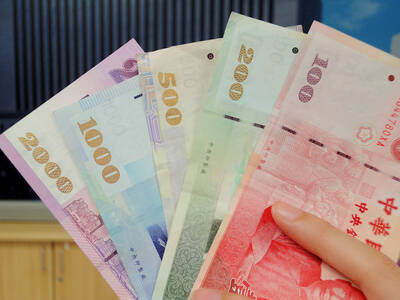In a move likened to two rival sports teams playing home games on the same pitch, traders from Chicago’s Mercantile Exchange are moving onto the floor of the Chicago Board of Trade (CBOT) today.
The marriage of convenience has produced the world’s largest and most diverse financial exchange where daily trading averaged US$4.5 trillion in contracts last year. Rival NYSE Euronext averaged US$2.5 trillion.
Chicago has been a global center for derivatives ever since the CBOT began offering the world’s first futures contracts in 1851, based on the likely prices of farming products in the US Midwest.
While the merger was welcomed by most traders as the only way to remain competitive as exchanges around the world formed alliances and launched competing products, working in the same room with their arch rival was a bitter pill for some to swallow.
For more than a century the exchanges were rival fraternities jostling for status, power and customers.
The CBOT was older, better-known and the bastion of the city’s South Side Irishmen. The scrappier Merc, founded in 1898, was dominated by traders from the North Side and managed to grow to twice the CBOT’s daily volume.
Traders drank in different bars and used different hand signals and lingo in the pits.
“If we had proposed it five years earlier, we might have got shot,” former CBOT chairman Charles Carey, who is now the group’s vice chairman, told Forbes magazine.
But in the past five years, traders have seen their pits empty out as electronic trading took over, now accounting for 80 percent of the volume on the combined exchanges.
Over-the-counter trading, which bypasses exchanges entirely, is also threatening their profits.
The Merc was forced to up its bid following a takeover campaign by Intercontinental Exchange (ICE).
The US$9.4 billion merger was completed in July.
An accident of real estate softened the blow for the CBOT. Since it owned its building, the Merc will get out of its lease and move into the CBOT’s stunning art deco landmark a few blocks away.
Construction began in September, a massive undertaking that is still under way.
Phone and data lines have to be moved, trading pit platforms are being shifted around the room and built, and noise has to be kept to a minimum during trading hours.
The Merc’s equities traders will be the first to move today. The commodities traders won’t arrive until May 19.
“It’ll be different. The cultures are different,” said Bill Brannigan, an independent S&P futures broker who joined the Merc in 1977.
“I think we’ll get the looks on the stairs when we open up,” he said. “And lets face it, we are going to their house, so we’re kind of working our way in there.”
Most traders realize the merger is only way to maintain their market share. And merging the floors will hopefully bring new life to the pits.
“It’s this huge, monster room and when they have it up and running at full capacity it’ll be dynamic,” Brannigan said in an interview on the last day he traded at the Merc.
“When they bring people down to that floor it’s going to rejuvenate it. The noise. The noise level’s going to different. It’ll be extremely exciting ... there’s going to be people everywhere,” he said.

People can preregister to receive their NT$10,000 (US$325) cash distributed from the central government on Nov. 5 after President William Lai (賴清德) yesterday signed the Special Budget for Strengthening Economic, Social and National Security Resilience, the Executive Yuan told a news conference last night. The special budget, passed by the Legislative Yuan on Friday last week with a cash handout budget of NT$236 billion, was officially submitted to the Executive Yuan and the Presidential Office yesterday afternoon. People can register through the official Web site at https://10000.gov.tw to have the funds deposited into their bank accounts, withdraw the funds at automated teller

PEACE AND STABILITY: Maintaining the cross-strait ‘status quo’ has long been the government’s position, the Ministry of Foreign Affairs said Taiwan is committed to maintaining the cross-strait “status quo” and seeks no escalation of tensions, the Ministry of Foreign Affairs (MOFA) said yesterday, rebutting a Time magazine opinion piece that described President William Lai (賴清德) as a “reckless leader.” The article, titled “The US Must Beware of Taiwan’s Reckless Leader,” was written by Lyle Goldstein, director of the Asia Program at the Washington-based Defense Priorities think tank. Goldstein wrote that Taiwan is “the world’s most dangerous flashpoint” amid ongoing conflicts in the Middle East and Russia’s invasion of Ukraine. He said that the situation in the Taiwan Strait has become less stable

CONCESSION: A Shin Kong official said that the firm was ‘willing to contribute’ to the nation, as the move would enable Nvidia Crop to build its headquarters in Taiwan Shin Kong Life Insurance Co (新光人壽) yesterday said it would relinquish land-use rights, or known as surface rights, for two plots in Taipei’s Beitou District (北投), paving the way for Nvidia Corp to expand its office footprint in Taiwan. The insurer said it made the decision “in the interest of the nation’s greater good” and would not seek compensation from taxpayers for potential future losses, calling the move a gesture to resolve a months-long impasse among the insurer, the Taipei City Government and the US chip giant. “The decision was made on the condition that the Taipei City Government reimburses the related

FRESH LOOK: A committee would gather expert and public input on the themes and visual motifs that would appear on the notes, the central bank governor said The central bank has launched a comprehensive redesign of New Taiwan dollar banknotes to enhance anti-counterfeiting measures, improve accessibility and align the bills with global sustainability standards, Governor Yang Chin-long (楊金龍) told a meeting of the legislature’s Finance Committee yesterday. The overhaul would affect all five denominations — NT$100, NT$200, NT$500, NT$1,000 and NT$2,000 notes — but not coins, Yang said. It would be the first major update to the banknotes in 24 years, as the current series, introduced in 2001, has remained in circulation amid rapid advances in printing technology and security standards. “Updating the notes is essential to safeguard the integrity